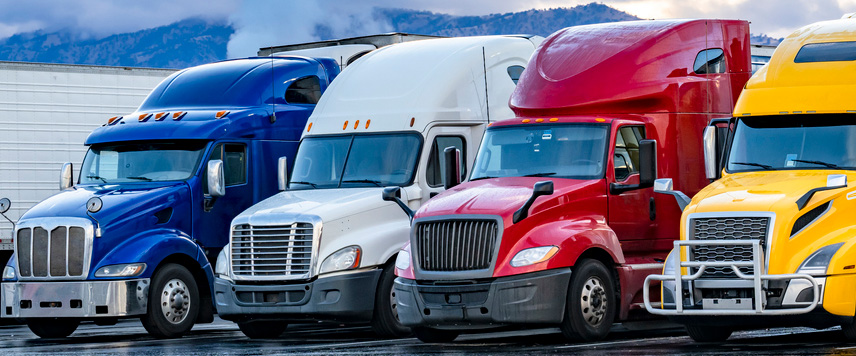Electric vehicles are slowly becoming more prevalent on the highways and byways of, not just the U.S., but the entire world. Everyone has seen more Teslas moving in and out of traffic, and charging stations are starting to pop up in cities across the country. Electric vehicles, or EVs, are at the forefront of transportation technology today, and more of them are being sold to consumers every day. For those trying to limit the number of fossil fuels being burned, this is all fantastic news. Some lawmakers and politicians are even pushing to stop having gas-powered vehicles sold in the U.S. All of this seems drastic and new, but the shift promises to look even more so in the next few years.
However, while personal EVs are going to continue to climb in numbers and popularity, what does this mean for the trucking industry? Everyone may want to help the planet by cutting dependence on fossil fuels, but people still need goods transported from one area to another, and, so far, trucking is still the most efficient way to do that. With EVs still in developmental stages, trucking companies are trying to prepare themselves for the inevitable changes to come in the future. Today, this post is going to study where electric trucks are today, at the beginning of 2024, and where the industry hopes they’ll be in the coming years, or maybe even sooner.
“It’s ELECTRIC!”
2023 was supposed to be a huge year for EVs, but there were several issues that led to delays in multiple, pivotal areas. First, while developers are still looking at adding charging stations in various places in the country, they are far behind schedule in getting them built and functional. Every EV owner knows the importance of charging areas, but there are also power grids to consider. A fleet of electric trucks would need an extremely large amount of electricity to fully charge up, and the places to charge these trucks would need to have full and unfettered access to the power required. In real estate, alone, millions of dollars will be needed to properly fund the development, building, and maintenance of charging stations for public and private uses.
Along with places to charge the EVs, the electric trucks themselves need to be built! Right now, demand is outweighing the supply of EVs available. Tesla Semis began production in 2023, but, as with many others, this product has been hampered by severe delays. Since the company has been confirmed by the North American Council for Freight Efficiency to have the most efficient charging capabilities, demand has skyrocketed even more. The trucks should be able to travel up to 500 miles, and it charges faster than most other EVs. However, Elon Musk’s prediction that Tesla can produce 50,000 of the heavy-duty trucks this year seems to be “the stretchiest of stretch goals,” according to FreightWaves earlier this month. With all of the news and drama surrounding Tesla, these trucks could be years away.
Luckily, Tesla is far from the only company developing these types of trucks. Mercedes-Benz Trucks, Freightliner, Volvo, and others are working to get their electric trucks ready to meet the needs of companies who know consumers want them to switch to cleaner shipping methods. Along with the new EVs, the trucking industry is responding to environmental concerns by also studying and developing trucks that run off of natural gas, hydrogen, and even renewable biofuels. Investments are also being made to test “charging lanes,” or an interstate lane that has the ability to charge EVs. A few of these are being tested today, but they are far from ready for a mass deployment. These goals, advanced by both regulatory and consumer pressures, will be making waves in the industry for years to come.
“On the road again…”
Most everyone believes that EVs are the future of the trucking industry, but, as seen in 2023, the road ahead for them is long and difficult. 2024 seems to promise more progress, but there are “miles to go before I sleep.” So, what lies ahead for the trucking industry when it comes to electric trucks?
One of the first issues that appears when people begin discussing the future of electric trucks is the state of California. One of the states leading the charge for a full conversion to EVs, California has mandated that all truck be either electric or emissions-free by 2042. Being one of the first states to make this move, it has, of course, led to an uproar among industry insiders. The upfront costs of purchasing electric trucks and providing the charging stations are far from financially safe decisions at this stage. In order to combat this, California also started a program called the Hybrid and Zero-Emission Truck and Bus Voucher Project, or HVIP for short. Providing tens of millions of dollars to trucking companies, this program means that these businesses are eligible to get up $168,000 in tax credits to purchase a Class-8 battery-electric truck. While large companies took huge chunks of this program money, California has extended HVIP to try and help smaller trucking companies go electric this year.
In December, Maryland and Rhode Island adopted California’s mission to advance clean trucking. Now, ten states have these rules in place, and they are giving trucking companies similar amounts of time to get their fleets switched over to electric vehicles. Experts see this shift beginning to take place in legislatures in remaining states over the next few months and years.
Another piece of the puzzle includes the development of EVs in the medium-duty truck range. As these types of trucks become hybrids and electric in Europe, companies like Daimler are beginning to ship them over to the U.S. Because medium-duty trucks are not made for transporting goods over large stretches of interstate, companies have found that it makes sense to develop electric versions of them. Along with Daimler, companies like Mack and Isuzu find that medium-duty trucks are perfect for having shorter, set routes, and then they return to their home base, which allows them to be charged regularly, usually overnight. Start looking for these to appear in more and more cities across the U.S.!
Some experts, such as Mark Roeth from the North American Council for Freight Efficiency, believe that electric trucks can even help maintain higher driver retention rates. Frito-Lay, for example, has purchased and begun using Ford e-transit delivery trucks in the northeast of the U.S. Now, drivers are finding that the EVs handling, acceleration, smoothness, and quiet operation is causing older drivers to stay on longer now that they don’t have to deal with the roughness of the ride in a diesel truck. While many drivers are hesitant to test them, some of the older drivers at Frito-Lay are now training younger workers on the EVs, and they are enjoying the ride more. With driver retention at the forefront of many trucking companies’ issues, anything that can lead to keeping drivers is worth looking into.
Conclusion
As stated earlier, simply charging electric trucks has become a lesson in how many different industries must come together to make it all work. From real estate developers to battery manufacturers to finding the drivers willing to test all of this out for the future, there is a long road ahead for EVs. Some companies are fighting back against state mandates, saying that the timelines given are not possible given the amount of testing and development still needed for these trucks. Others say that the trucks are still too expensive to even begin to consider purchasing at this point. Still, EVs are here to stay, and it will be interesting to see how they progress towards the open road in 2024.
__________________________________________________________________________
Meaghan Goldberg covers recruitment and digital marketing for Lionzone. A Patterson, GA native, after graduating from both Valdosta State University and Middle Tennessee State University, Meaghan joined Lionzone in 2018 as a digital recruitment strategist before becoming the social media manager.
Resources:
https://www.freightwaves.com/news/electric-trucks-should-shake-off-setbacks-in-2024
https://www.drivebigtrucks.com/blog/truck-driving-trends-2024/
https://www.washingtonpost.com/climate-solutions/2024/01/18/electric-truck-drivers-vehicles/
https://www.trucking.org/news-insights/2024-californias-electric-truck-mandates-collide-reality




